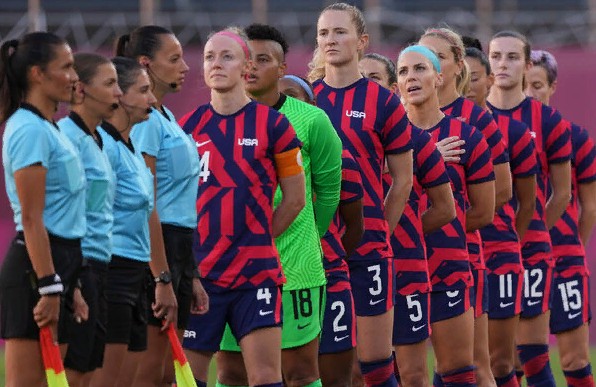A six-year pay dispute between key members of the World Cup-winning United States women’s soccer team and their sport’s national governing body came to an end on Tuesday morning with a settlement that included a multimillion-dollar payment to the players and a promise from their federation to equalize pay between the men’s and women’s national teams.
The athletes — a group of several dozen current and past women’s national team players — will split $24 million in payouts from the federation, U.S. Soccer, under the terms of the agreement. Back pay accounts for the majority of the sum, implying that compensation for men’s and women’s teams had been unbalanced for years.
Perhaps more remarkable than the money — at least for the players — is U.S. Soccer’s vow in the teams’ future collective bargaining agreements to equalize pay between the men’s and women’s national teams in all competitions, including the World Cup.
That chasm was originally thought to be impenetrable, barring any form of settlement; if it is bridged by the federation in negotiations with both clubs, millions of money might be funneled to a new generation of female athletes.
The agreement is conditional on the ratification of a new contract between US Soccer and the women’s team’s players’ union. It will settle all remaining allegations in the gender discrimination case launched by the players in 2019.
In a telephone interview, U.S. Soccer president Cindy Parlow Cone said, «It wasn’t an easy road to get to this place for sure.» «What matters most is that we’re moving forward, and we’re moving forward together.»
The deal represents a costly end to a years-long court battle that has harmed U.S. Soccer’s reputation, harmed its relationships with sponsors, and ruined its relationship with some of its most popular players, including Alex Morgan, Megan Rapinoe, and Carli Lloyd. U.S. Soccer was under no obligation to reach an agreement with the women’s team; a federal court had dismissed the players’ equal pay claims in 2020, effectively depriving them of nearly all legal leverage, and the players’ appeal seemed unlikely to succeed.
As a result, the settlement represents an unexpected victory for the players: nearly two years after losing in court in a devastating decision, they were able to extract not only an eight-figure settlement but also a commitment from the federation to implement the very reforms that the judge had rejected.
Morgan called the settlement «a major win for us, and for women» in a phone interview.
«What we wanted was for U.S. Soccer to acknowledge discrimination, and we got that through back pay in the settlement,» she explained. We set out to get fair and equal treatment in the workplace, and we were successful thanks to the working conditions settlement. We also set a goal for ourselves and the men’s squad through US Soccer to have equal pay moving forward, which we achieved.»
The women’s players agreed to release the federation from all remaining claims in the team’s gender discrimination complaint in exchange for the reimbursement and U.S. Soccer’s promise to address equal pay in future contracts with its two flagship teams.
It’s possible that the process will take months. The men’s and women’s teams have already had joint negotiating sessions with US Soccer, but in order for the deal to work — the federation is seeking a single collective bargaining agreement that covers both national teams — the men’s players association will have to agree to share or surrender, millions of dollars in potential World Cup payments from FIFA, the sport’s governing body.
These payments, which are established by FIFA and are exponentially higher for the men’s World Cup than the women’s equivalent, are at the heart of the wage gap.
In September, Cone, a former member of the women’s team, stated that the federation would not sign new collective bargaining agreements with either team unless the prize money for the World Cup was equalized. On Tuesday, the women’s team’s players association congratulated its members and their lawyers «on their historic success in fighting decades of discrimination perpetuated by the United States Soccer Federation,» but made it clear that it intended to hold U.S. Soccer — and, by extension, the men’s team — accountable for their public promises to support equal pay.
«Although today’s agreement is a huge step forward,» the union added, «much work remains to be done.»
The players’ long battle with U.S. Soccer, which is not only their employer but also the governing body of the sport in the United States, has catapulted them to the forefront of a broader fight for gender equality in sports, garnering support from fellow athletes, celebrities, politicians, and presidential candidates. In recent years, players, clubs, and even sportsmen from other sports — Olympic gold medalists in ice hockey, Canadian soccer stars, and W.N.B.A. players — have turned to the U.S. players and their union for advice on how to achieve similar salary and working circumstances.
Even as the U.S. players’ case dragged on, several of those players and teams were able to secure significant advances — Norway, Australia, and the Netherlands are among the countries whose soccer federations have committed to reducing the pay gap between men and women.
The quest for equitable compensation began almost six years ago when five outstanding players filed a lawsuit with the Equal Employment Opportunity Commission alleging wage discrimination by US Soccer. The women, who were crucial members of a team that was the reigning World Cup and Olympic champions at the time, said they were paid as little as 40% of what men’s national team players were paid. Morgan, Rapinoe, Lloyd, Hope Solo, and Becky Sauerbrunn, among the others, claimed they were shortchanged on bonuses, appearance fees, and even meal money while at training camps.
«The numbers speak for themselves,» Solo asserted, though the United States Soccer Federation (USSF) quickly refuted him. «We get paid more to just turn up than we do to win major tournaments,» Solo said of men’s players.
Soccer fans quickly took sides in the conflict, dividing U.S. Soccer down the middle. The federation briefly contended that the men earned more money and had bigger television ratings, so they deserved more money, but it quickly backtracked after public outcry, player outrage, and a closer reading of the equal pay statute.
By that time, the sides had already exchanged the first of many shots in the media and in court. After a humiliating error in which one of its court papers forgot to redact the home addresses and personal email accounts of roughly two dozen prominent players, the federation won a judgment that prevented players from boycotting the 2016 Olympics while they campaigned for new contracts.
Later depositions resulted in intense exchanges, which the public-relations-savvy women’s players exploited on social media and in T-shirt slogans. They did, however, make statements that the players would not forgive.
U.S. Soccer’s lawyers contended in a court filing in March 2020, months after the women’s team won their second consecutive Women’s World Cup, that playing for the men’s squad needed greater «talent» and «responsibility» than playing for the women’s team.
«It’s incredibly distressing to see obvious misogyny and sexism used against us,» Rapinoe said, adding, «I know we’re in a heated struggle, but that crossed a line.»
U.S. Soccer issued an apology and overhauled its legal team, but the chasm had grown even wider. The head of the federation resigned the next day, and the women set a settlement price of $67 million. U.S. Soccer countered with a $9 million offer.
Since April 2020, when the judge in the women’s lawsuit, R. Gary Klausner of the United States District Court for the Central District of California, dismissed the argument that they were systematically underpaid and said that U.S. Soccer had substantiated its claim that the women’s team had earned more «on both a cumulative and an average per-game basis» than the men’s team during the years covered by the lawsuit, a settlement has seemed the most likely way out for the sides.
One of the case’s great ironies was that the women’s team had become a victim of its own success. The women had chosen the exact worst time to line up a few years of their salaries against a few years of the men’s compensation, since the men at the time were foundering competitively, by fighting U.S. Soccer while they were at the top of their powers as World Cup champions.
The men became ineligible for millions of dollars in performance bonuses after failing to qualify for the lone men’s World Cup played during the lawsuit’s timeline, while the women received bonuses — twice — for winning their World Cup and secured increased compensation after successfully negotiating new contracts.
The women promised to fight the judge’s decision, and a pact on working conditions suggested that a solution may yet be reached. Cone, a former player for the United States women’s national team, had expressed her continued to hope that a larger contract would put the dispute behind U.S. Soccer and the team, as well as her aspirations for a «new relationship» with the women’s team and a chance to «rebuild trust» between the two sides.



Be the first to comment on "Equal Pay Lawsuit Between US Women’s Soccer Players and US Soccer Is Settled"